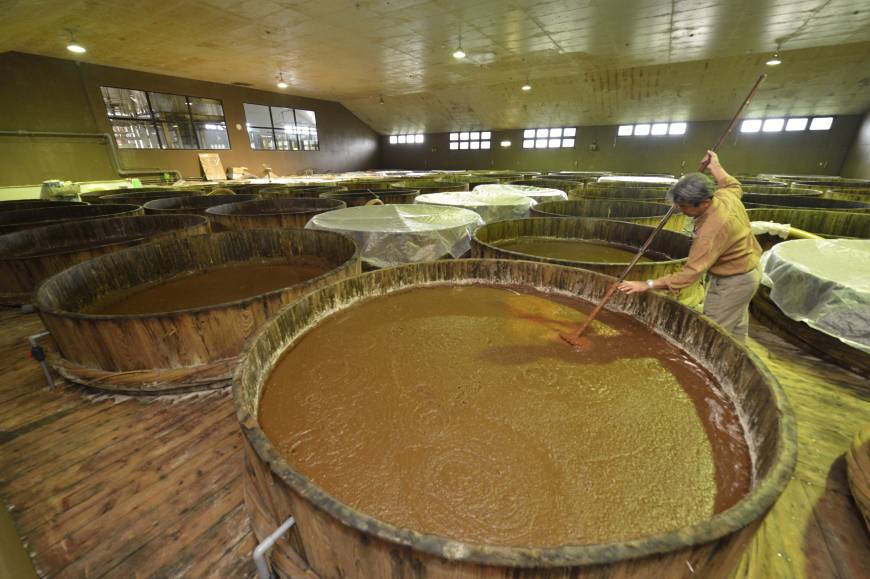by Nancy Singleton Hachisu posted on The Japan Times on April 29, 2014
 Soy boy: Kazuhiko Morita stirs a giant vat of moromi at Yamaki Jozo, a plant in Saitama that produces soy sauce, tofu, miso and more using natural methods. | KENJI MIURA
Soy boy: Kazuhiko Morita stirs a giant vat of moromi at Yamaki Jozo, a plant in Saitama that produces soy sauce, tofu, miso and more using natural methods. | KENJI MIURA
Although rice is certainly the king of Japanese food, soybeans are the queen. Small makers of miso, soy sauce and tofu dot the landscape of Japan, but blink once and you will notice that the local shops are closing up as supermarket culture takes over daily life.
Up in the hills above our northern Saitama town lies Yamaki Jozo, an organic miso/soy sauce/tofu/natto/pickle company surrounded by prolific vegetable fields and thoughtfully designed Japanese gardens. It is the ultimate wabi-sabi experience. But it is not just for the elegance of this so-called “soy sauce plant” that I take all visitors there (foreign and Japanese alike). What Yamaki offers is myriad, and only depends on time and the emptiness of your stomach.
When we have advance notice, I book seats at its weekend tofu restaurant, Shisuian. The kaiseki multi-course lunch is a steal at ¥3,024, and the bentō (boxed lunches) only ¥1,543. Otherwise we just hop in the car willy-nilly and cruise up the winding road to the Kamikawa-machi hills, about 15 minutes from our farmhouse. After sampling the various tofus (silk, cotton, yuzu, sesame, yuba), misos (inaka, brown rice, barley, soy bean) and pickles (too many to list!), we climb the stairs from the retail shop and peer through the glass at the monstrous cedar barrels of soy sauce left to ferment over the course of two years. If we are lucky, product-planning manager Kazuhiko Morita will be around to dole out a taste of the deeply primal soy-sauce mash (moromi). According to Morita, it’s not for sale, since “it would be like selling our soul.”
Upstairs is where Yamaki holds workshops and demonstrations in making miso and tofu and pressing soy sauce, as well as tastings. (I occasionally take my little English-immersion preschool students there for a tour, conveniently conducted in English.)
Yamaki Jozo is all about transparency, and the current plant was built with the visitors who would cross through its halls, all wanting to see exactly how the soy sauce, miso and tofu are produced, firmly in mind. But more than that, Yamaki built the plant thinking of the restful feeling we would get as we wind our way along the path leading toward the whitewashed buildings, or when we turn a corner and come across ikebana moments upstairs. Here is Japan at its best: delicious wares, responsibly grown organic ingredients and a pristine setting.
I sometimes sneak away for a ¥957 curry lunch or udon set prepared by the excellent cooks who tend the Yamaki shop (and I’m not usually a fan of curry or udon). There are three veteran ladies who are in charge of the shop, and I often ask for their sage advice in pickling or using kōji (mold spores). They are the smiling (and knowledgeable) faces of the shop.
And I never leave empty handed. Yamaki products are my favorite presents to take when I go overseas; the packaging has that elegant aesthetic sense one often associates with Japan (but is sometimes hard to find), and what is inside is absolutely top quality.
Although Yamaki is several generations old, it was the current president, Tomio Kitani, who, inspired by veteran natural farmer Kazuo Suka, committed to using 100 percent organic soybeans about 40 years ago. Historically the miso and soy sauce fermenting was done in Honjo, a neighboring city; and the tofu-making operation was located in Kamiizumi-mura, the neighboring mountain village that was recently merged with our town, Kamikawa-machi. Tofu (and soy sauce) rely on the best water available, so being near the mountains from which the clear spring water is trucked was essential. Yamaki built the current plant on the site of the tofu operation in 2002 and moved all of the soybean-related activities up to the Kamiizumi-mura hills.
Kitani views organic farming as normal — the natural way to grow food. Consequently, he feels an innate responsibility to make traditional Japanese products the way they have been made for generations and to shun modern shortcuts. And that sense of history is exactly why Kitani is aligned with the venerable House of Shijo in support of the ancient food traditions of Japan. Tsukasake Shijo, the 41st-generation Shijo head of this very old Kyoto family, comes out to Yamaki Jozo twice a year for the ceremonial rice planting and harvesting, and invites Kitani each year for an audience with the Emperor to present him with soy sauce.
The vast majority of Japanese people consume soy sauce produced from defatted soy grits rather than whole soybeans and do not even know the difference. Kitani puts the current food culture into perspective with these apt words: “It has taken only 70 years to destroy a 1,000-year-old food tradition.”
Put like that, people might want to think twice before reaching for mass-produced soy sauce over artisanal, family-made soy sauce — especially now that washoku (Japanese cuisine) has been designated as an Intangible Cultural Heritage by Unesco. Perhaps we should actually live up to the honor.
Original Article: The Japan Times
http://www.japantimes.co.jp/life/2014/04/29/food/natural-miso-soy-factory-always-full-beans/#.U27X21dzY7w

